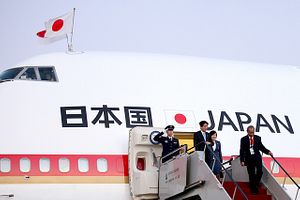Japan’s prime minister started his nine-day tour of Latin American countries last Friday with a weekend visit to Mexico. So far trade and energy deals have featured heavily during his visit, although he also took time to make a cultural stop along his tour. As Mexico looks to bring major oil and shale gas fields under development, Japan is eager to invest and direct a part of that supply toward its own markets. While so far Abe’s trip has meet with success, it will not only be measured against Chinese President Xi Jinping’s recent tour, but also by how much support he can garner for Japanese influence and investment.
On Friday Abe attended a bilateral summit with Mexican President Enrique Peña Nieto in Mexico City, where the two agreed to boost cooperation to increase stable energy supplies. The memorandum of understanding signed by Japan Oil, Gas and Metals National Corp. (JOGMEC) and Mexico’s state-controlled Pemex is significant for both parties. For Mexico this is another step toward revitalizing its national energy company with foreign investment and expertise. After Nieto’s new law was enacted last December allowing for Pemex to partner with foreign companies (while still not allowing for those countries to buy shares in Pemex), the oil company has been on the lookout for new partners to develop its deep water offshore fields,like the one east of the U.S.-Mexico border near Texas in the Perdido area, reportedly home to between 150 and 200 million barrels of oil.
According to the Japan News, the deal is expected to include cooperation in the technical development of the gas industry, with the long-term plan of building pipelines from fields in the Gulf of Mexico to the west coast, where the natural gas would be liquefied and shipped to Japan by the mid-2020s. Japan will already have begun importing LNG from the U.S. later this decade, but that gas will have higher costs since it will have to be shipped further through the Panama Canal. Japanese government sources say they hope for Japanese companies to participate in the development of the natural gas fields, pipelines and LNG facilities with an overall investment estimated at 1 trillion yen ($9.8 billion).
Amid Abe’s negotiations in Mexico, he also took time to visit the ancient city of Teotihuacan and climb to the top of the Pyramid of the Sun, where he later told reports he “prayed for Japan’s exit from deflation and local revitalization.” Never one to stray from his policy goals, he appears intent on keeping the public focus of his tour clearly on the economic gains for Japan to be found as he visits each country.
Abe will next visit Trinidad and Tobago, where he will attend the first Japan-Caribbean Community (CARICOM) summit in the hopes of signing deals in the areas of energy, fishing and disaster prevention with the community. In all likelihood this will be a minor economic stop before moving onto visits in Colombia, Chile, and finally Brazil. A government source with the Japanese delegation told the Japan Times that a joint statement expected to be signed on Tuesday with Colombian President Juan Manuel Santos to increase Japanese participation in the development of key natural resources like oil and coal. The source also said the deal could lead to Colombia becoming biggest destination for Japanese firms in Latin America, after only Brazil, as Japan’s energy concerns will continue to stay at the forefront of negotiations during Abe’s tour.
As his last stop, Abe is likely hoping that Brazil will be the crowning achievement of his tour, and while stealing the headlines from Xi’s visit may be difficult, if not impossible, there is certainly room for the two countries to make significant deals. Japan is expected to make a significant investment in Brazilian infrastructure, specifically to develop rail, ports and roads to increase connection to the Cerrado region where Japan invests heavily in soybean production.
However, it will be difficult to replicate the impact of Xi’s visit, when the BRICS New Development Bank was announced. Alongside that deal, Xi also signed a $35 billion regional fund, with $20 billion dedicated to regional infrastructure projects and $10 billion in credit, as well as a $5 billion deal with Brazil’s mining industry and a the purchase of $3.2 billion in Brazilian commercial aircraft. Japan can no longer hope to match China in terms of sheer volume of investment, but must seek to sign deals that target industries where Japan enjoys technological advantages (like rail and construction), and areas where it severely lacks its own adequate domestic production capabilities (like energy and agriculture). So far Abe appears to have laid the groundwork for a successful visit in those respects, even if he will not come home to the accolades Xi enjoyed.

































